Effect of Meteorological Patterns on the Intensity of Streambank Erosion in a Proglacial Gravel-Bed River (Spitsbergen)
Abstract
:1. Introduction
2. Study Area
3. Survey Strategy and Methods
3.1. Location and Choice of Measurement Site
3.2. Geodesic Measurements of Changes in the Channel Cross-Sections
3.3. Determination of Streambank Erosion Indices and Widening of the Channel
4. Results
4.1. Hydro-Meteorological Conditions during the Measurement Period
4.2. Annual Intensity of Channel Processes in the Scott River
4.3. Inter-Seasonal Intensity of Channel Processes in the Scott River during the 2012–2013 Ablation Seasons
5. Discussion
6. Conclusions
Acknowledgments
Author Contributions
Conflicts of Interest
References
- Hagen, J.O.; Kohler, J.; Melvold, K.; Winther, J.G. Glaciers in Svalbard: Mass balance, runoff and freshwater flux. Polar Res. 2003, 22, 145–159. [Google Scholar] [CrossRef]
- Ballantyne, C.K. A general model of paraglacial landscape response. Holocene 2002, 12, 371–376. [Google Scholar] [CrossRef]
- Ballantyne, C.K. Paraglacial geomorphology. Quat. Sci. Rev. 2002, 21, 1935–2017. [Google Scholar] [CrossRef]
- Ballantyne, C.K. Paraglacial landform succession and sediment storage in deglaciated mountain valleys: Theory and approaches to calibration. Z. Geomorphol. Suppl. 2003, 132, 1–18. [Google Scholar]
- Mercier, D. Paraglacial and paraperiglacial landsystems: Concepts, temporal scales and spatial distribution. Géomorphologie 2008, 14, 223–233. [Google Scholar] [CrossRef]
- Warburton, J. An alpinie proglacial fluvial sediment budget. Geogr. Ann. A 1990, 72, 261–272. [Google Scholar] [CrossRef]
- Warburton, J. Sediment budgets and rates of sediment transfer across cold environments in Europe: A commentary. Geogr. Ann. A 2007, 89, 95–100. [Google Scholar] [CrossRef]
- Lane, S.N.; Bakker, M.; Gabbud, C.; Micheletti, N.; Saugy, J.N. Sediment export, transient landscape response and catchment-scale connectivity following rapid climate warming and Alpine glacier recession. Geomorphology 2017, 277, 210–227. [Google Scholar] [CrossRef]
- Kostrzewski, A.; Kaniecki, A.; Kapuściński, J.; Klimaczak, R.; Stach, A.; Zwoliński, Z. The dynamics and rate of denudation of glaciated and non-glaciated catchments, central Spitsbergen. Pol. Polar Res. 1989, 10, 317–367. [Google Scholar]
- Marren, P.M.; Toomath, S.C. Fluvial adjustments in response to glacier retreat: Skaftafellsjökull, Iceland. Boreas 2013, 42, 57–70. [Google Scholar] [CrossRef]
- Marren, P.M.; Toomath, S.C. Channel pattern of proglacial rivers: Topographic forcing due to glacier retreat. Earth Surf. Proc. Landf. 2014, 39, 943–951. [Google Scholar] [CrossRef]
- Owczarek, P.; Nawrot, A.; Migała, K.; Malik, I.; Korabiewski, B. Flood-plain responses to contemporary climate change in small high-Arctic basins (Svalbard, Norway). Boreas 2014, 43, 384–402. [Google Scholar] [CrossRef]
- Beylich, A.; Laute, K. Sedimet sources, spatiotemporal variability and rates of fluvial bedload transport in glacier-connected steep mountain valleys in western Norway (Erdalen and Bødalen drainage basins). Geomorphology 2015, 228, 552–567. [Google Scholar] [CrossRef]
- Carrvick, J.L.; Heckmann, T. Short-term geomorphological evolution of proglacial systems. Geomorphology 2017, 287, 3–28. [Google Scholar] [CrossRef]
- Hasholt, B. Hydrology and Transport of Material in the Sermilik Area 1972. Geogr. Tidsskr. Den. 1976, 75, 30–39. [Google Scholar] [CrossRef]
- Hodgkins, R. Glacier hydrology in Svalbard, Norwegian high arctic. Quat. Sci. Rev. 1997, 16, 957–973. [Google Scholar] [CrossRef]
- Hodgkings, R.; Cooper, R.; Wadham, J.; Tranter, M. Suspended sediment fluxes in a high-Arctic glacierised catchment: Implications for fluvial sediment storage. Sediment. Geol. 2003, 162, 105–117. [Google Scholar] [CrossRef]
- Hodgkins, R.; Cooper, R.; Wadham, J.; Tranter, M. The hydrology of the proglacial zone of high-Arctic glacier (Finsterwalderbreen, Svalbard). Atmospheric and surface water fluxes. J. Hydrol. (Amst.) 2009, 378, 150–160. [Google Scholar] [CrossRef] [Green Version]
- Hodgkins, R.; Tranter, M.; Dowdeswell, M.A. The characteristics and formation of a high-arctic proglacial icing. Geogr. Ann. A 2004, 86, 265–275. [Google Scholar] [CrossRef]
- Hodson, A.; Tranter, M.; Gurnell, A.; Clark, M.; Hagen, J.O. The hydrochemistry of Bayelva, a high Artic progalcial stream in Svalbard. J. Hydrol. (Amst.) 2002, 257, 91–114. [Google Scholar] [CrossRef]
- Maizels, J.K. Channel changes, paleohydrology and deglaciation: Evidence from some Late Galcial sandur deposits of Northeast Scotland. Quat. Study Pol. 1983, 4, 171–187. [Google Scholar] [CrossRef]
- Orwin, J.F.; Lamoureux, S.F.; Warburton, J.; Beylich, A.A. A framework for characterizing fluvial sediment fluxes from source to sink in cold environments. Geogr. Ann. A 2010, 92, 155–176. [Google Scholar] [CrossRef]
- Rachlewicz, G. Floods in high Arctic Valley systems and their geomorfologic effects (examples from Billefjorden, Central Spitsbergen). Landf. Anal. 2007, 5, 66–70. [Google Scholar]
- Rachlewicz, G. Contemporary Sediment Fluxes and Relief Changes in High Arctic Glacierized Valley Systems (Billefjorden, Central Spitsbergen); sec. Geografia, No. 87; Adam Mickiewicz University Press: Poznań, Poland, 2009; p. 213. [Google Scholar]
- Rachlewicz, G. River floods in glacier-covered catchments of the high Arctic: Billefjorden- Wijdefjorden, Svalbard. Nor. Geogr. Tidsskr. 2009, 63, 115–122. [Google Scholar] [CrossRef]
- Sobota, I.; Nowak, M.; Weckwerth, P. Long-term changes of glaciers in north-western Spitsbergen. Glob. Planet. Chang. 2016, 144, 182–197. [Google Scholar] [CrossRef]
- Kociuba, W.; Janicki, G. Continuous measurements of bedload transport rates in a small glacial river catchment in the summer season (Spitsbergen). Geomorphology 2014, 212, 58–71. [Google Scholar] [CrossRef]
- Kociuba, W.; Janicki, G.; Siwek, K. Dynamics of changes the bed load outflow from a small glacial catchment (West Spitsbergen). In Monitoring, Simulation, Prevention and Remediation of Dense Debris Flow III; de Wrachien, D., Brebbia, C.A., Eds.; WITPress: Southampton, UK, 2010; pp. 261–270. [Google Scholar]
- Kociuba, W.; Janicki, G.; Siwek, K. Variability of sediment transport in the Scott River catchment (Svalbard) during the hydrologically active season of 2009. Quaest. Geogr. 2014, 33, 39–49. [Google Scholar] [CrossRef]
- Kociuba, W. Assessment of sediment sources throughout the proglacial area of a small Arctic catchment based on high-resolution digital elevation models. Geomorphology 2017, 287, 73–89. [Google Scholar] [CrossRef]
- Kociuba, W. Determination of the bedload transport rate in a small proglacial High Arctic stream using direct, semi-continuous measurement. Geomorphology 2017, 287, 10–115. [Google Scholar] [CrossRef]
- Beylich, A.A. Mass Transfers and Sedimentary Budgets in Geomorphologic Drainage Basin Studies. In Advanced Topics in Mass Transfer; El-Amin, M., Ed.; InTech: Rijeka, Croatia, 2011; pp. 399–422. ISBN 978-953-307-333-0. [Google Scholar]
- Zwolinski, Z. Hydrological polar monitoring–methodical proposition. Monit. Nat. Environ. 2007, 8, 29–39. (In Polish) [Google Scholar]
- Kociuba, W. The Mechanism and Dynamics of Sediment Supply and Fluvial Transport in a Glacial Catchment; Maria Curie-Sklodowska University Press: Lublin, Poland, 2015. (In Polish) [Google Scholar]
- Kociuba, W. Measurements of bedload flux in a high Arctic environment. In Source-to-Sink-Fluxes in Undisturbed Cold Environments; Beylich, A.A., Dixon, J.C., Zwoliński, Z., Eds.; Cambridge University Press: Cambridge, UK, 2016; pp. 116–132. [Google Scholar]
- Beylich, A.A. Quantitative studies on sediment fluxes and sediment budgets in changing cold environments–potential and expected benefit of coordinated data exchange and the unification of methods. Landf. Anal. 2007, 5, 9–10. [Google Scholar]
- Rachlewicz, G.; Zwoliński, Z.; Kociuba, W.; Stawska, M. Field testing of three bedload samplers’ efficiency in a gravel-bed river, Spitsbergen. Geomorphology 2017, 287, 90–100. [Google Scholar] [CrossRef]
- Marren, P.M. Magnitude and frequency in proglacial rivers: A geomorphological and sedimentological perspective. Earth Sci. Rev. 2005, 70, 203–251. [Google Scholar] [CrossRef]
- Kociuba, W.; Janicki, G. Spatiotemporal variability of the channel pattern of high Arctic proglacial rivers. In Fluvial Geomorphology and Riparian Vegetation: Environmental Importance, Functions and Effects on Climate Change; Duncan, N., Ed.; Nova Science Publishers, Inc.: New York, NY, USA, 2015; pp. 53–80. [Google Scholar]
- Kociuba, W.; Janicki, G.; Dyer, J.L. A multi-dimensional analysis of channel patterns of the proglacial Scott River reflected in environment catchment change. Land. Degrad. Dev. 2018, in press. [Google Scholar]
- Midgley, T.L.; Fox, G.A.; Heeren, D.M. Evaluation of the bank stability and toe erosion model (BSTEM) for predicting lateral streambank retreat on composite streambanks. Geomorphology 2012, 145–146, 107–114. [Google Scholar] [CrossRef]
- Daly, E.R.; Miller, R.B.; Fox, G.A. Modeling streambank erosion and failure along protected and unprotected composite streambanks. Adv. Water Res. 2015, 81, 114–127. [Google Scholar] [CrossRef]
- Lotsari, E.; Wang, Y.; Kaartinen, H.; Jaakkola, A.; Kukko, A.; Vaaja, M.; Hyyppä, A.; Hyyppä, J.; Alho, P. Gravel transport by ice in a subarctic river from accurate laser scanning. Geomorphology 2015, 246, 113–122. [Google Scholar] [CrossRef]
- Froehlich, W. Dynamics of fluvial transport in the Kamienica Nawojowska. Geogr. Stud. 1975, 114, 1–122. (In Polish) [Google Scholar]
- Froehlich, W. The mechanism of fluvial transport and waste supply into the stream channel in a mountainous flysch catchment. Geogr. Stud. 1982, 143, 1–144. (In Polish) [Google Scholar]
- Trucotte, B.; Brian Morse, B.; Bergeron, N.E.; Roy, A.G. Sediment transport in ice-affected rivers. J. Hydrol. 2011, 409, 561–577. [Google Scholar] [CrossRef]
- Tremblay, P.; Robert Leconte, R.; Lacey, R.W.J.; Bergeron, N. Multi-day anchor ice cycles and bedload transport in a gravel-bed stream. J. Hydrol. 2014, 519, 364–375. [Google Scholar] [CrossRef]
- Requena, P.; Weichert, R.B.; Minor, H.E. Self widening by lateral erosion in gravel bed rivers. In River Flow; Ferreira, R.M.L., Alves, E.C.T.L., Leal, J.G.A.B., Cardoso, A.H., Eds.; Taylor & Francis Group: London, UK, 2006; pp. 1801–1809. ISBN 0-415-40815-6. [Google Scholar]
- Picco, L.; Tonon, A.; Rainato, R.; Lenzi, M. Bank erosion and large wood recruitment along a gravel bed river. J. Agric. Eng. 2016, 47, 72–81. [Google Scholar] [CrossRef]
- Fox, G.A.; Sheshukov, A.; Cruse, R.; Kolar, R.L.; Guertault, L.; Gesch, K.R.; Dutnell, R.C. Reservoir sedimentation and upstream sediment sources: Perspectives and future research needs on streambank and gully erosion. Environ. Manag. 2016, 57, 945–955. [Google Scholar] [CrossRef] [PubMed]
- Fox, G.A.; Wilson, G.V. The role of subsurface flow in hillslope and stream bank erosion: A review. Soil Sci. Soc. Am. J. 2010, 74, 717–733. [Google Scholar] [CrossRef]
- Bartoszewski, S.; Gluza, A.; Siwek, K.; Zagórski, P. Temperature and rainfall control of outflow from the Scott Glacier catchment (Svalbard) in the summers of 2005 and 2006. Nor. Geogr. Tidsskr. 2009, 63, 107–114. [Google Scholar] [CrossRef]
- Kociuba, W.; Janicki, G.; Siwek, K.; Gluza, A. Bedload transport as an indicator of contemporary transformations of arctic fluvial systems. In Monitoring, Simulation, Prevention and Remediation of Dense and Debris Flows IV; de Wrachien, D., Brebbia, C.A., Mambretti, S., Eds.; WIT Press: Boston, UK, 2012; pp. 125–135. [Google Scholar]
- Bartoszewski, S. Regime of outflow of the Wedel Jarlsberg’s Land rivers (Spitsbergen). In Faculty of Biology and Earth Sciences Maria Curie-Sklodowska University in Lublin; Habilitation Dissertations 40; Maria Curie-Skłodowska University Press: Lublin, Poland, 1998. (In Polish) [Google Scholar]
- Franczak, L.; Kociuba, W.; Gajek, G. Runoff Variability in the Scott River (SW Spitsbergen) in Summer Seasons 2012–2013 in Comparison with the Period 1986–200. Quaest. Geogr. 2016, 35, 39–50. [Google Scholar] [CrossRef]
- Kociuba, W.; Janicki, G. Changeability of movable bed-surface particles in natural, gravel-bed channels and its relation to bedload grain size distribution (Scott River, Svalbard). Geogr. Ann. A 2015, 97, 507–521. [Google Scholar] [CrossRef]
- Surfer® User’s Guide. Contouring and 3D Surface Mapping for Scientists and Engineers; Golden Software, LLC: Golden, CO, USA, 2015. [Google Scholar]
- Medrak, K.; Gluza, A.; Siwek, K.; Zagórski, P. The meteorological conditions on the Calypsobyen in summer 2014 on the background of multiyear 1986–2011. Probl. Klimatol. Polarnej 2014, 24, 37–50. (In Polish) [Google Scholar]
- Bartoszewski, S.; Gluza, A.; Siwek, K.; Zagórski, P. The functioning of Scott Glacier in conditions of climate global changes. Landf. Anal. 2007, 5, 5–8. [Google Scholar]
- Zagórski, P.; Siwek, K.; Gluza, A.; Bartoszewski, S. Changes in the extent and geometry of the Scott Glacier, Spitsbergen. Pol. Polar Res. 2008, 29, 163–185. [Google Scholar]
- Rodzik, J.; Gajek, G.; Reder, J.; Zagórski, P. Glacial Geomorphology. In Geographical Environment of NW Part of Wedel Jarlsberg Land (Spitsbergen, Svalbard); Zagórski, P., Harasimiuk, M., Rodzik, J., Eds.; Maria Curie-Sklodowska University Press: Lublin, Poland, 2013; pp. 36–165. [Google Scholar]
- Østrem, G.; Bridg, C.W.; Rannie, W.F. Glacio-hydrology, discharge and sediment transport in the Decade Glacier area, Baffin Island, N.W.T. Geogr. Ann. A 1967, 49A, 268–282. [Google Scholar] [CrossRef]
- Hammer, K.M.; Smith, N.D. Sediment production and transport in proglacial stream: Hilda Glacier, Alberta, Canada. Boreas 1983, 12, 91–106. [Google Scholar] [CrossRef]
- Ashworth, P.J.; Ferguson, R.I. Interrelationships of channel processes, changes and sediments in a proglacial braided river. Geogr. Ann. A 1986, 68, 361–371. [Google Scholar] [CrossRef]
- Ferguson, R.I.; Ashworth, P.J. Spatial patterns of bedload transport and channel change in braided and near-braided rivers. In Dynamics of Gravel-Bed Rivers; Billi, P., Hey, R.D., Thorne, C.R., Tacconi, P., Eds.; John Wiley: Chichester, UK, 1992; pp. 477–496. [Google Scholar]
- Pearce, J.T.; Pazzaglia, F.J.; Evenson, E.B.; Lawson, D.E.; Alley, R.B.; Germanoski, D.; Denner, J.D. Bedload component of glacially discharged sediment: Insights from the Matanuska Glacier, Alaska. Geology 2003, 31, 7–10. [Google Scholar] [CrossRef]
- Leopold, L.B.; Wolman, M.G.; Miller, J.P. Fluvial Processes in Geomorphology; W.H. Fremann & Co.: San Francisco, CA, USA, 1964; pp. 1–522. [Google Scholar]
- Montgomery, D.R.; Buffington, J.M. Channel processes, classification and response. In River Ecology and Management; Naiman, R., Biłby, R., Eds.; Springer: New York, NY, USA, 1988; pp. 13–42. [Google Scholar]
- Teisseyre, A.K. River classification in the light of analysis of the fluvial system and hydraulic geometry. Prace Geol. Mineral. 1991, 22, 1–204. (In Polish) [Google Scholar]
- Bisson, A.; Montgomery, D.R.; Buffington, J.M. Valley Segments, Stream eaches, and Channel Units. In Methods in Stream Ecology; Elsevier: Amsterdam, The Netherlands, 2017. [Google Scholar]
- Beylich, A.A.; Laute, K. Combining impact sensor field and laboratory flume measurements with other techniques for studying fluvial bedload transport in steep mountain streams. Geomorphology 2014, 218, 72–87. [Google Scholar] [CrossRef]
- Palmer, J.A.; Schilling, K.E.; Isenhartc, T.M.; Schultz, R.C.; Tomerd, M.D. Streambank erosion rates and loads within a single watershed: Bridging the gap between temporal and spatial scales. Geomorphology 2014, 209, 66–78. [Google Scholar] [CrossRef]
- Analysis of Source-To-Sink Fluxes and Sediment Budgets in Changing High-Latitude and High-Altitude Cold Environments, 1st ed.; Beylich, A.A.; Warburton, J. (Eds.) SEDIFLUX Manual; Norwegian Geological Survey Report: Oslo, Norway, 2007; pp. 1–158. [Google Scholar]
- Szpikowski, J.; Szpikowsk, G.; Zwolińskia, Z.; Rachlewicz, G.; Kostrzewski, A.; Marciniak, M.; Dragon, K. Character and rate of denudation in a High Arctic glacierized catchment (Ebbaelva, Central Spitsbergen). Geomorphology 2014, 218, 52–62. [Google Scholar] [CrossRef]
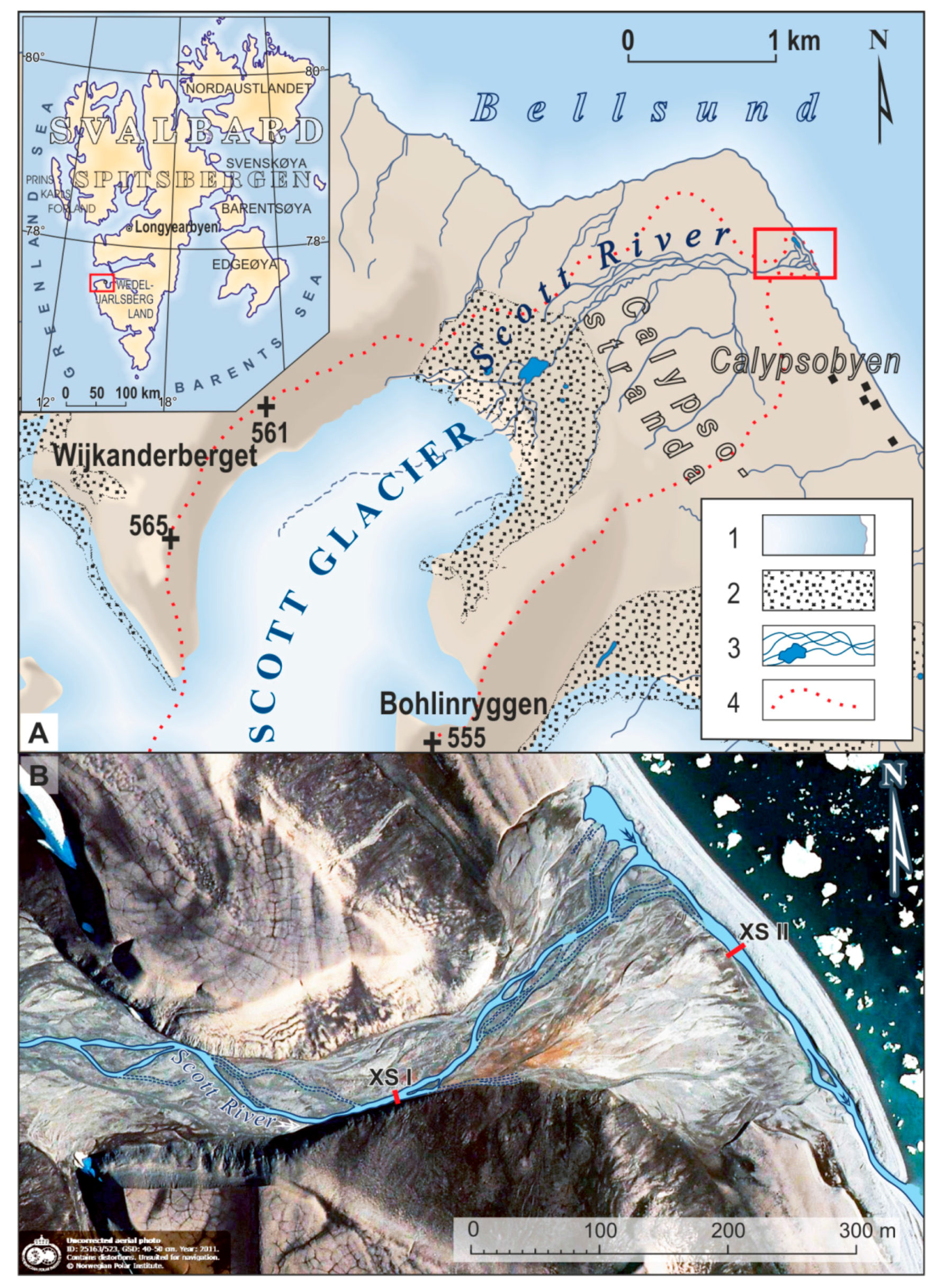


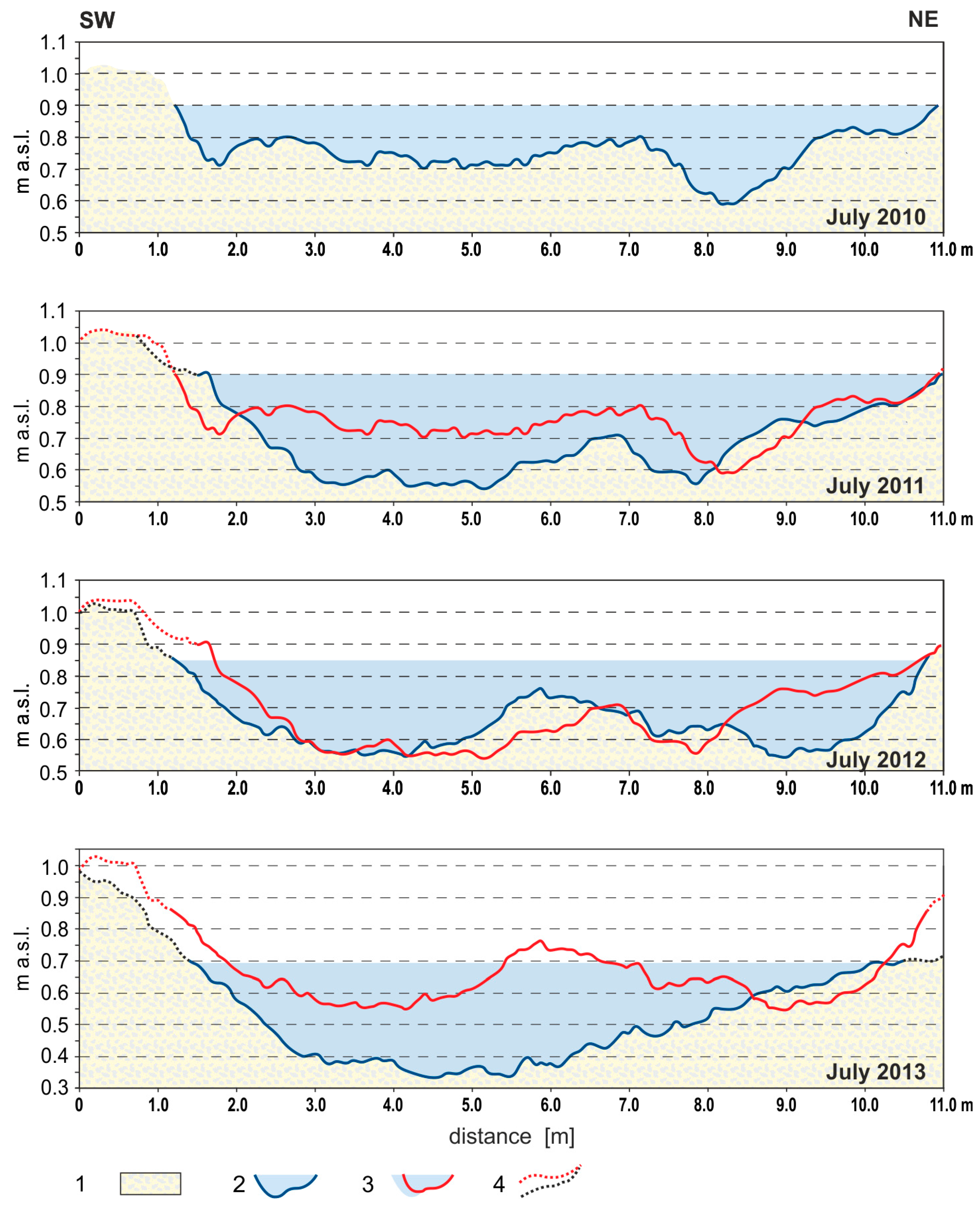
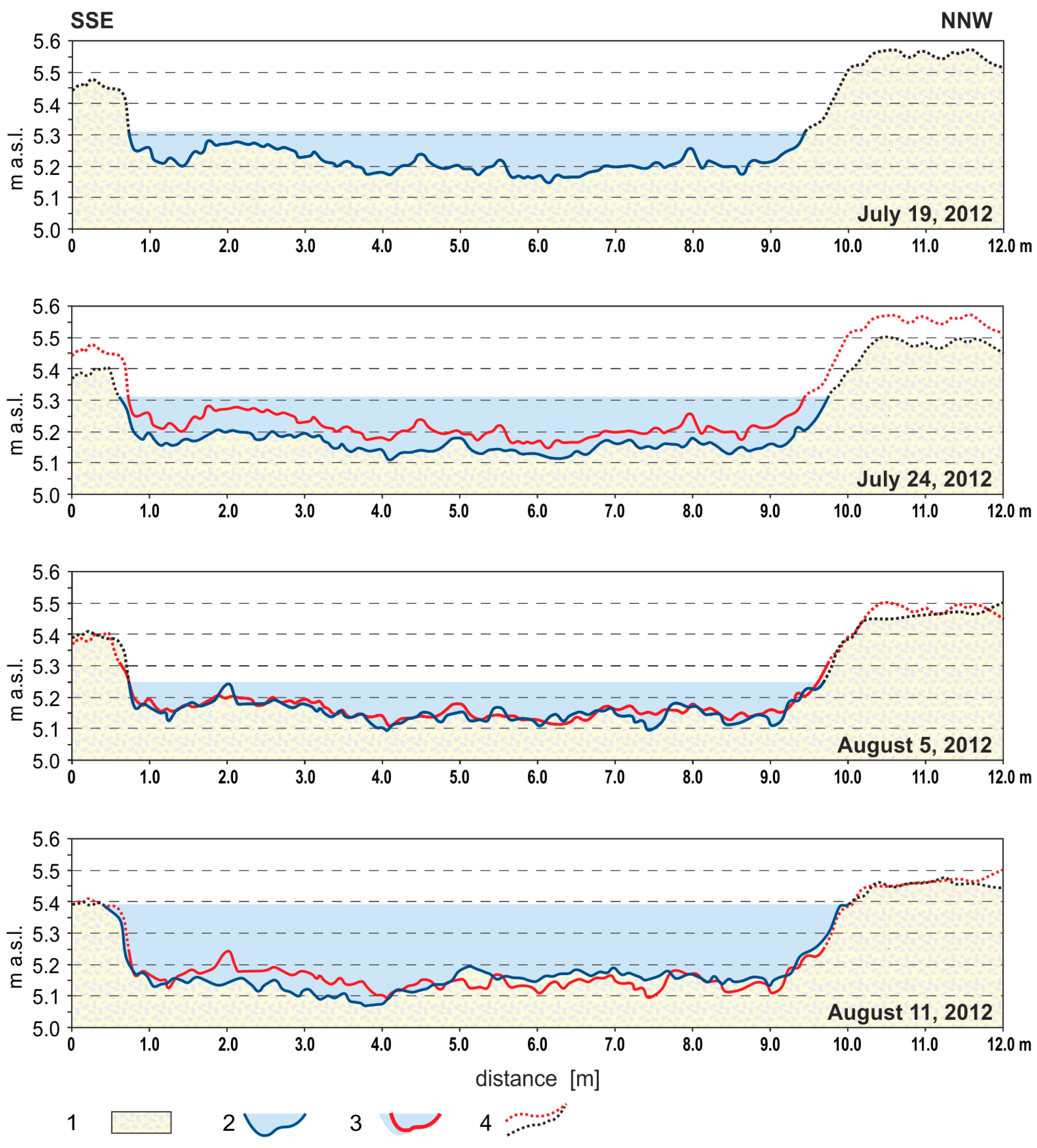

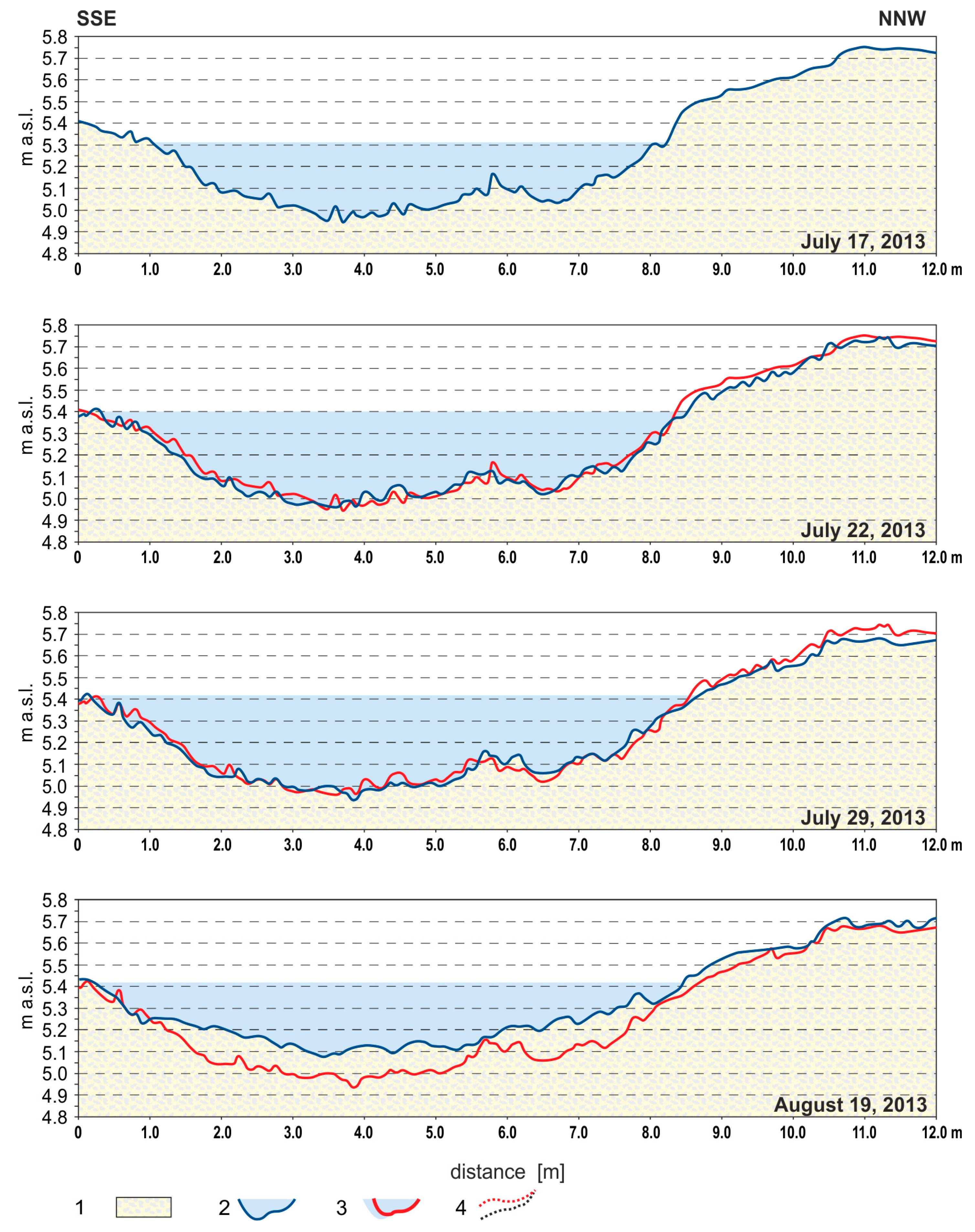
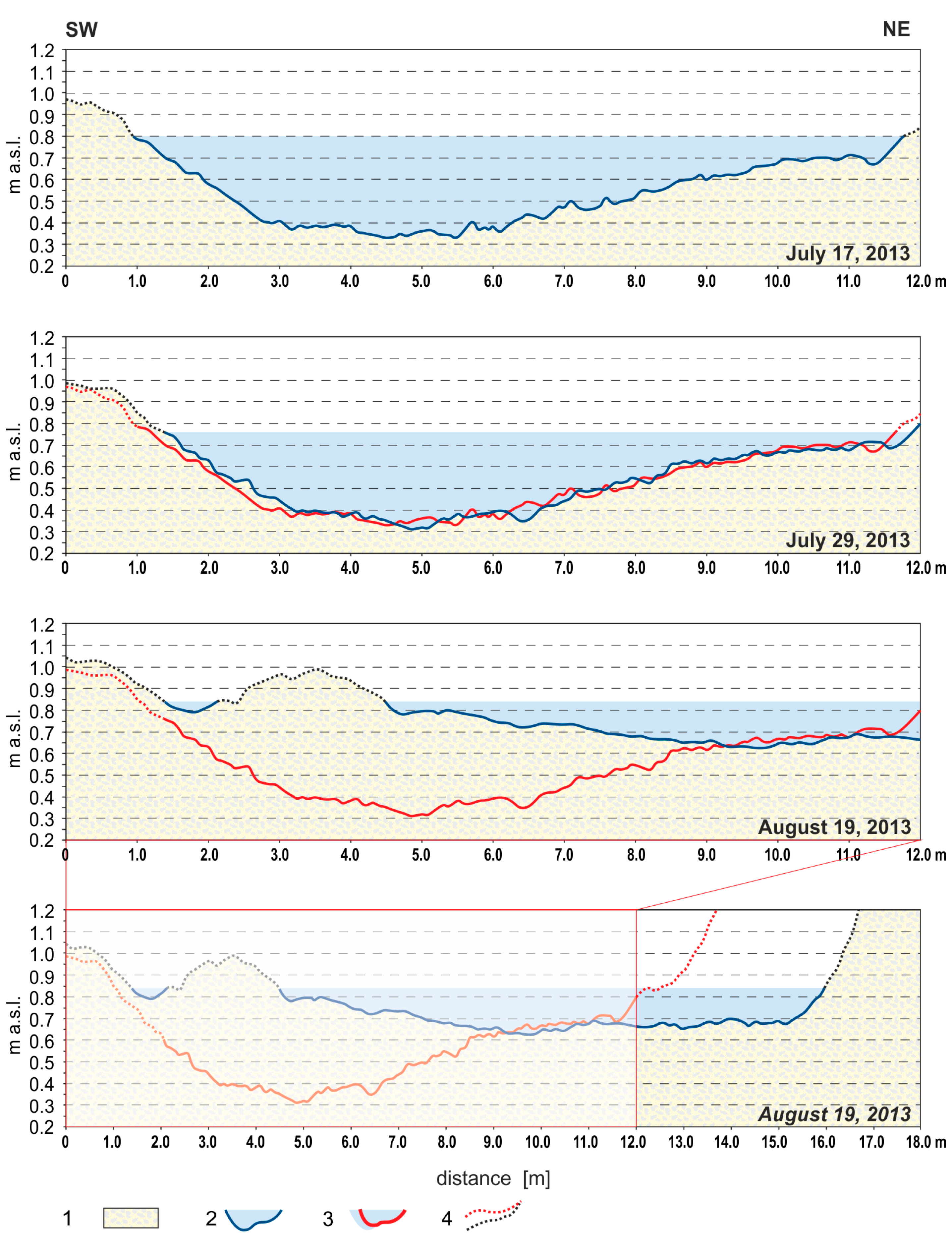
| Season | Air Temperature (°C) | Precipitation Sum Total (mm) | Water Temperature (°C) | Channel Wide (m) | Water Velocity (m·s−1) | Water Discharge (m3·s−1) |
|---|---|---|---|---|---|---|
| 2009 10.07–06.09 | 2.0–7.0 (4.9) * | 18.1 | - | 7–11 | - | 1.3–2.4 (2.0) |
| 2010 27.06–10.08 | 1.9–6.2 (4.5) | 8.6 | - | 9.2–10.4 (10.0) | 0.58–1.13 (0.71) | 0.7–1.8 (1.19) |
| 2011 09.07–23.08 | 1.5–7.2 (3.7) | 12.0 | - | - | - | - |
| 2012 12.07–23.08 | 2.0–7.1 (4.6) | 23.5 | 1.6–4.4 (3.2) | - | - | 0.3–2.2 (0.9) |
| 2013 10.07–18.08 | 2.7–7.9 (5.7) | 98.9 ** | 2.0–3.0 (2.8) | - | - | 0.74–2.7 (1.8) |
| 2009–2013 | 1.5–6.2 (4.7) | (32.2) | 1.6–4.4 (3.0) | - | - | 0.3–2.7 (1.5) |
| 1986–2011 | 0.2–10.2 (5.0) | (32.4) | - | - | - | 0.8–2.4 (0.96) * |
| Channel Processes | ||||||||||||
|---|---|---|---|---|---|---|---|---|---|---|---|---|
| SSE Streambank | Channel Bottom | NNW Stream Bank | Channel Total | |||||||||
| Time | S (m2) | F (m2) | B (m2) | S (m2) | F (m2) | B (m2) | S (m2) | F (m2) | B (m2) | S (m2) | F (m2) | B (m2) |
| A. Cross-section I (XS I) | ||||||||||||
| July, 2009 | - | - | - | - | - | - | - | - | - | - | - | - |
| July, 2010 | 0.06 | 0.01 | −0.05 | 0.18 | 0.01 | −0.17 | 0.22 | 0.13 | −0.08 | 0.45 | 0.15 | −0.31 |
| July, 2011 | 0.06 | 0.02 | −0.04 | 0.18 | 0.47 | +0.29 | 0.49 | 0 | −0.49 | 0.73 | 0.49 | −0.24 |
| July, 2012 | 0.04 | 0.04 | 0 | 0.23 | 0.07 | −0.16 | 0 | 0.11 | +0.11 | 0.27 | 0.22 | −0.05 |
| July, 2013 | 0.01 | 0.11 | +0.1 | 0.57 | 0.0 | −0.57 | 0 | 1.16 | +1.16 | 0.58 | 1.27 | +0.69 |
| B. Cross-section II (XS II) | ||||||||||||
| July, 2010 | - | - | - | - | - | - | - | - | - | - | - | - |
| July, 2011 | 0 | 0.07 | +0.07 | 0.82 | 0 | −0.82 | 0.05 | 0.07 | +0.02 | 0.87 | 0.14 | −0.73 |
| July, 2012 | 0.18 | 0 | −0.18 | 0.02 | 0.22 | +0.20 | 0.35 | 0 | −0.35 | 0.55 | 0.22 | −0.33 |
| July, 2013 | 0.32 | 0 | −0.32 | 1.25 | 0.0 | −1.25 | 0.34 | 0.09 | −0.25 | 1.91 | 0.09 | −1.82 |
| Channel Processes | ||||||||||||
|---|---|---|---|---|---|---|---|---|---|---|---|---|
| Time | SSE Streambank | Channel Bottom | NNW Stream Bank | Channel Total | ||||||||
| S (m2) | F (m2) | B (m2) | S (m2) | F (m2) | B (m2) | S (m2) | F (m2) | B (m2) | S (m2) | F (m2) | B (m2) | |
| A. Cross-section I (XS I) | ||||||||||||
| 2012 year | ||||||||||||
| 19 July | - | - | - | - | - | - | - | - | - | - | - | - |
| 24 July | 0.08 | 0 | −0.08 | 0.75 | 0 | −0.75 | 0.24 | 0 | −0.24 | 1.07 | 0 | −1.07 |
| 5 August | 0.01 | 0.02 | +0.01 | 0.07 | 0.06 | −0.01 | 0.05 | 0.01 | −0.04 | 0.13 | 0.09 | −0.04 |
| 11 August | 0.02 | 0 | −0.02 | 0.28 | 0.11 | −0.17 | 0.02 | 0.02 | 0 | 0.32 | 0.13 | −0.19 |
| 2013 year | ||||||||||||
| 17 July | - | - | - | - | - | - | - | - | - | - | - | - |
| 22 July | 0.04 | 0.01 | −0.03 | 0.08 | 0.06 | −0.02 | 0.10 | 0.01 | −0.09 | 0.22 | 0.08 | −0.14 |
| 29 July | 0.06 | 0.01 | −0.05 | 0.05 | 0.05 | 0 | 0.13 | 0.03 | −0.10 | 0.24 | 0.09 | −0.15 |
| 19 August | 0.01 | 0.01 | 0 | 0 | 0.8 | +0.8 | 0 | 0.13 | +0.13 | 0.01 | 0.94 | +0.93 |
| B. Cross-section II (XS II) | ||||||||||||
| 2012 year | ||||||||||||
| 19 July | - | - | - | - | - | - | - | - | - | - | - | - |
| 24 July | 0.19 | 0 | −0.19 | 0.45 | 0 | −0.45 | 0.06 | 0 | −0.06 | 0.70 | 0 | −0.70 |
| 5 August | 0.13 | 0 | −0.13 | 0.91 | 0.18 | −0.73 | 0.22 | 0 | −0.22 | 1.26 | 0.18 | −1.08 |
| 11 August | 0 | 0.04 | +0.04 | 0.08 | 0.63 | +0.55 | 0.12 | 0.20 | +0.08 | 0.20 | 0.76 | +0.50 |
| 2013 year | ||||||||||||
| 17 July | - | - | - | - | - | - | - | - | - | - | - | - |
| 29 July | 0.14 | 0 | +0.14 | 0.13 | 0.04 | −0.09 | 0.05 | 0.03 | −0.02 | 0.32 | 0.07 | −0.25 |
| 19 August | 0 | 0.09 | +0.09 | 0.08 | 2.55 | +2.47 | 1.77 | 0 | −1.77 | 1.85 | 2.64 | +0.79 |
| I.d. | Period | Wetted Area (m2) | Changes of Bedrock Top | Maximal Channel Width * (m) | Channel Widening (m) | |
|---|---|---|---|---|---|---|
| Area (m2) | Index (m2) | |||||
| Cross-section I (XS I) | ||||||
| 1 | VII 2009 | 2.14 | 3.88 | - | 8.74 | - |
| 2 | VII 2010 | 1.96 | 3.69 | −0.19 | 6.0 | −1.74 |
| 3 | VII 2011 | 1.58 | 3.48 | −0.21 | 10.03 | +4.03 |
| 4 | VII 2012 | 1.70 | 3.44 | −0.04 | 9.58 | −0.45 |
| 5 | VII 2013 | 1.90 | 3.60 | +0.16 | 7.77 | −1.81 |
| Cross-section II (XS II) | ||||||
| 1 | VII 2010 | 1.48 | 4.19 | - | 9.75 | - |
| 2 | VII 2011 | 2.20 | 3.48 | −0.71 | 9.51 | −0.24 |
| 3 | VII 2012 | 1.99 | 3.16 | −0.32 | 9.97 | +0.46 |
| 4 | VII 2013 | 1.98 | 2.71 | −0.44 | 11.42 | +1.45 |
© 2018 by the authors. Licensee MDPI, Basel, Switzerland. This article is an open access article distributed under the terms and conditions of the Creative Commons Attribution (CC BY) license (http://creativecommons.org/licenses/by/4.0/).
Share and Cite
Kociuba, W.; Janicki, G. Effect of Meteorological Patterns on the Intensity of Streambank Erosion in a Proglacial Gravel-Bed River (Spitsbergen). Water 2018, 10, 320. https://doi.org/10.3390/w10030320
Kociuba W, Janicki G. Effect of Meteorological Patterns on the Intensity of Streambank Erosion in a Proglacial Gravel-Bed River (Spitsbergen). Water. 2018; 10(3):320. https://doi.org/10.3390/w10030320
Chicago/Turabian StyleKociuba, Waldemar, and Grzegorz Janicki. 2018. "Effect of Meteorological Patterns on the Intensity of Streambank Erosion in a Proglacial Gravel-Bed River (Spitsbergen)" Water 10, no. 3: 320. https://doi.org/10.3390/w10030320





